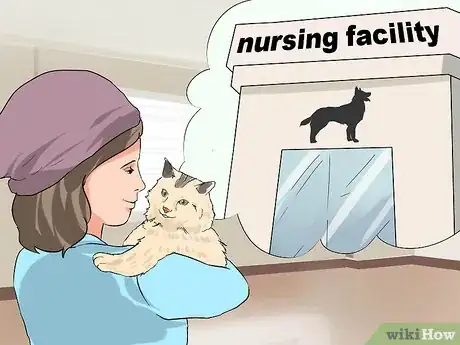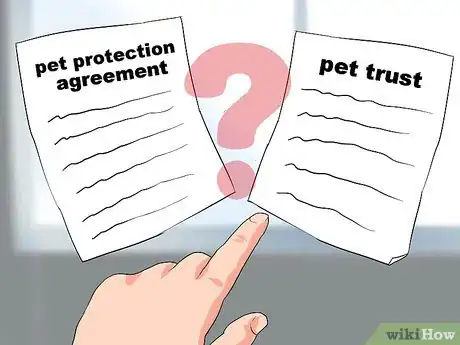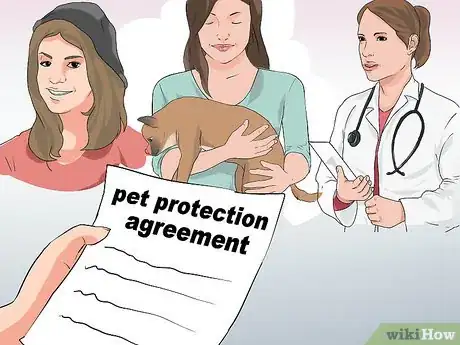This article was co-authored by Clinton M. Sandvick, JD, PhD. Clinton M. Sandvick worked as a civil litigator in California for over 7 years. He received his JD from the University of Wisconsin-Madison in 1998 and his PhD in American History from the University of Oregon in 2013.
There are 7 references cited in this article, which can be found at the bottom of the page.
This article has been viewed 14,031 times.
If you are worried about whether your pets will be taken care of when you die or should you become disabled, you can create either a pet protection agreement or a pet trust. Each document can protect your beloved pets, but there are some differences between the two. To choose between the two, you should take inventory of your needs.
Steps
Identifying the Differences
-
1Understand the purposes of these documents. Both a pet trust and a pet protection agreement are legally-enforceable instruments that provide for your pets in case you die or become disabled. In these documents, you name one or more people to take care of your pets and provide detailed instructions for their care.
-
2Check if you can afford an attorney. You will need a lawyer's assistance to draft a pet trust.[1] It could cost you $1,000 or more to have a lawyer draft the trust for you.
- You can create a pet protection agreement without a lawyer's assistance. Although you may see sample trust documents floating around the Internet, you really need a lawyer to draft a trust that will be valid in your state.
Advertisement -
3Consider if you want the pet with you in a nursing home. Another key difference is that a pet protection agreement cannot guarantee that a pet will be able to live with you in a long-term care facility.
- By contrast, you can draft a pet trust so that any nursing home that takes your pet along with you will receive a portion of the trust funds. This can provide a powerful incentive to a nursing home to take your pet.
-
4Figure out how much money you intend to leave. If you are leaving a substantial sum of money for your pet's care, then you should probably use a pet trust instead of a pet protection agreement.[2] With a trust, the trustee will be able to manage the assets so that they last as long as possible.
- If you have the money, then a trust makes sense if your pet is very young. A pet that you expect to live for a decade or more could cost a substantial sum of money.
-
5Find out if your heirs will challenge your decision. A pet trust is also ideal if you expect your heirs (for example, your children) to challenge your decision to leave money to your pet. If so, a pet trust is preferable to a pet protection agreement.[3]
- Think about your relationship with your heirs. Are you on good terms? Do they understand how much you love your pets? If not, then your heirs might challenge your attempt to leave money for the care of your pets.
-
6Choose between the two documents. It is ultimately your decision whether to choose a pet protection agreement or a pet trust. They are very similar. Both will provide for your pets' care after you die or if you become disabled. To make a decision, you need to weigh the following:
- Whether you can afford an attorney. If you can't, then you should pick a pet protection agreement.
- How badly you want your pets with you in a long-term care facility, should you have to live in one. Using a pet trust over a pet protection agreement increases the likelihood that you can live with your pets.
- The amount of money you will leave. A large sum of money could induce a legal challenge from your heirs. A pet trust provides added protection that your wishes will be recognized.
- How likely your heirs are to challenge your wishes. If you think they might challenge your pet agreement, then you should probably choose a pet trust.
Drafting a Pet Trust
-
1Find a lawyer. If you decide that you want to create a pet trust, then you should find an experienced trust and estates lawyer. You should ask friends or colleagues for a recommendation. You can also visit your state's bar association, which should run a referral program.
- You can also get attorney recommendations from your local animal welfare organization.[4]
- Always be sure that the trust attorney has actually created a pet trust before. A pet trust has different wrinkles than a regular trust, and you want an attorney who has experience creating pet trusts.
-
2Choose a trustee. In order to create the trust, you will need to name a trustee. The trustee is the person who is legally obligated to carry out the trust. He or she will manage the funds in the trust.
- You should pick someone who you are confident can handle money prudently. This person may or may not also be the caregiver.
- You should also pick a successor trustee in case your original trustee declines to serve or dies.[5]
-
3Pick a caregiver for each pet. In the trust, you will also name a caregiver. This person will actually care for your pet. Advisors recommend that the trustee and the caregiver not be the same person. This way, the caregiver and the trustee can act as “checks” on each other.[6]
- If you do not want the trustee and caregiver to be the same person, then you should make sure that these two people work well together. If they don't, then it could be difficult for the caregiver to get necessary funds out of the trustee.
- Remember to select a successor caregiver as well.
- If you have more than one pet, you will need to decide whether or not they should go to the same home. Pets who have bonded should probably be kept together.[7]
-
4Draft detailed instructions for your pet's care. When you meet with your attorney to discuss creating the trust, you should provide detailed instructions. Do not assume that the caregiver knows what you want.[8] You should give some thought to the following:
- Whether you want the caregiver to take your pet to a particular vet. You can also designate the number of times the pet must visit the vet in a year.[9]
- What kind of food the pet likes.
- The pet's routine: does it like a daily walk in the park, afternoon naps, etc.
- What kind of medical care you want provided to your pet. For example, you might request that “reasonable medical care” be provided in order to restore your pets to good health.[10]
- Whether you want the trustee to inspect your pets annually to make sure they are being taken care of.[11]
- Whether you want any of your pets euthanized if they are not in generally good health. Also, you should state what you want done with the remains.
-
5Set aside money. You will fund the trust with assets. These assets will then be used to care for your animal. You should talk to your lawyer about how much money you should put into the trust. If you put in too much, then your surviving relatives might challenge the trust as excessive.[12]
-
6Leave a portion of funds to your nursing home facility. To encourage a nursing home to let the pet move with you to a facility, you can include in your trust directions that a portion of the trust property will be given to any facility that allows you and your pets to stay together.
- You should also think about who to leave the assets to when the beneficiary (your pet) dies. Many people choose to leave money to an animal shelter or welfare organization.
-
7Sign in front of your lawyer. Your lawyer will arrange the execution of the trust so that it complies with all of your state's legal formalities. He or she should arrange for any witnesses and notary publics to attend the signing.
- Be sure to get a copy of your trust agreement from your lawyer. You should give copies to your vet, trustee, and caregiver.
Creating a Pet Protection Agreement
-
1Choose a guardian. The guardian will be the person who takes care of your animals in the event of your death or incapacity. You should speak to any potential guardians and ask them if they are willing to serve. You shouldn't name anyone until you are confident that they will be able to take care of your pets.
- Ideally, the guardian should have already met your pets.[13] Some people might agree to serve as a guardian without ever having met your pet. After spending some time together, they might change their mind.
- You can also name a successor guardian. For example, you might name your sister as your primary guardian but then name your niece as the successor. In the event that your sister dies or otherwise can't serve, your niece can take over as the guardian to your pets.
- You should also name a shelter or sanctuary as a retirement home in case your guardian and successor guardians die while your pets are still living.
-
2Pick successor beneficiaries. Your pets will not live forever, and if any money remains after they die, then that money must be distributed. You should think about who you want to receive these assets, should any remain.
-
3Complete the pet protection form. A sample/fillable pet protection form is available for $39 from legalzoom at http://www.legalzoom.com/personal/estate-planning/pet-protection-agreement-overview.html.
-
4Write your own agreement. You can also create your own pet protection agreement by typing up a letter and signing it in front of a notary and two witnesses. The guardian must also sign before the notary and witnesses. Be sure that the letter includes the following:[14]
- Your name and address.
- The name of the guardian (caregiver) and successor guardians.
- An organization of last resort to take your pet if none of your designated guardians can serve in the role.
- A description of your pets: name, type of animal, gender, and physical description (such as age, coat and eye color, and size).
- Detailed instructions for the pet's care.
- Any funds you have left for the pet's care. Name the source, such as a bank name and account number or life insurance company and policy number.
- The name of a distribution representative. This person will be in charge of holding the funds and distributing them to the guardian. Include the representative's name and contact information. Also name a successor distribution representative.
- The name of any successor beneficiaries. Include their names, addresses, and what percent of the money they will get after your pets die.
- The amount of compensation for the guardian and the distribution representative. You should discuss compensation with your guardian and distribution representative before drafting your pet protection agreement.
-
5Distribute copies. Once you have completed your pet protection agreement, you should give copies of the agreement to the following people:
- The caregiver
- Your veterinarian
- A close family friend (other than the caregiver)
-
6Set aside funds. Although funds are not required, you are advised to make a one-time payment when the agreement is signed. Make the payment to the caregiver. By making payment, you create a legal contract.
Warnings
- You cannot get a pet trust if you live in Minnesota. This is the only state in the U.S. in which pet trusts are invalid.[16]⧼thumbs_response⧽
References
- ↑ https://www.legalzoom.com/knowledge/pet-protection/faq/pet-protection-agreement-vs-pet-trust
- ↑ https://www.legalzoom.com/knowledge/pet-protection/faq/pet-protection-agreement-vs-pet-trust
- ↑ https://www.legalzoom.com/knowledge/pet-protection/faq/pet-protection-agreement-vs-pet-trust
- ↑ https://www.nerdwallet.com/blog/insurance/pet-trusts-life-insurance/
- ↑ https://www.nerdwallet.com/blog/insurance/pet-trusts-life-insurance/
- ↑ https://www.nerdwallet.com/blog/insurance/pet-trusts-life-insurance/
- ↑ https://www.petfinder.com/dogs/bringing-a-dog-home/providing-pets-future/
- ↑ https://www.nerdwallet.com/blog/insurance/pet-trusts-life-insurance/
- ↑ https://www.aspca.org/pet-care/pet-planning/pet-trust-primer
- ↑ https://www.petfinder.com/dogs/bringing-a-dog-home/providing-pets-future/
- ↑ https://www.aspca.org/pet-care/pet-planning/pet-trust-primer
- ↑ https://www.nerdwallet.com/blog/insurance/pet-trusts-life-insurance/
- ↑ https://www.petfinder.com/dogs/bringing-a-dog-home/providing-pets-future/
- ↑ http://www.legalzoom.com/samples/LegalZoom_Pet_Protection_Agreement_IL.pdf
- ↑ https://www.petfinder.com/dogs/bringing-a-dog-home/providing-pets-future/
- ↑ https://www.aspca.org/pet-care/pet-planning/pet-trust-primer
About This Article
To choose between a pet protection agreement and a pet trust, go with a pet protection agreement if you can't afford an attorney, since you'll need an attorney to draft a pet trust. However, if you can afford an attorney, you might want to go with a pet trust since it will offer more protection for your pet. For example, with a pet trust, you'll probably be able to bring your pet with you if you end up in a long-term care facility. Additionally, if your heirs try to challenge your decision, you'll have more protection with a pet trust than with a pet protection agreement. Don't worry if you can't afford an attorney though. A pet protection agreement will still provide for your pet's care, but it just might not be as powerful as a pet trust. For more advice from our Legal co-author, like how to choose a guardian or caregiver for your pet, keep reading.







































































